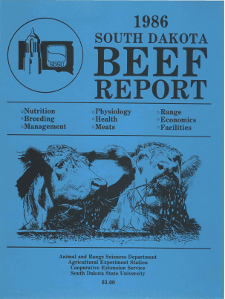
South Dakota Beef Report, 1986
Document Type
Report
Report Number
86-30
Publication Date
1986
Keywords
preconditioning, IBR, PI3, RSV, enterovirus, serology
Summary
Nasal swabs and blood samples were taken from a t o t a l of 400 calves on a preconditioning evaluation program during 2 years. Fifty calves from each of four South Dakota ranches were divided into preconditioned (PC) and control (CO) groups and sampled both on the ranch and in the feedlot. The preconditioning program followed the recommendations of the South Dakota Beef Cattle Improvement Association and the Extension Service and included vaccination with live virus vaccines for infectious bovine rhinotracheitis (IBR), bovine viral diarrhea (BVD) and parainfluenza-3 virus (PI3). In both years, viruses were isolated from calves on the ranches before vaccination. PI3 and IBR were readily isolated from calves that were vaccinated 2 weeks previously with a live intranasal IBR-PI3 virus vaccine. Fifty-six virus isolations were made from the 200 calves on arrival at the feedlot in the second year in contrast to six made the first year. Serum was tested for antibodies to IBR, BVD, respiratory syncytial virus (RSV) and PI3. Prevaccination antibodies were present to PI3 and BVD during the first year and to PI3, BM and RSV during the second year. Antibody levels varied among the ranches. Serologically, respiratory syncytial virus was present in the feedlot both years, although it was only isolated the second year. Serologic evidence from calves in the feedlot indicated that PI3 and RSV were the most prevalent viruses. There were no significant differences between the health scores of preconditioned and control calves and this may have been inf1uenced by the presence of other agents, i.e., respiratory syncytial virus and enteroviruses.
Number of Pages
7
Type
text
Format
application/pdf
Language
en
Publisher
South Dakota State University
Rights
Copyright © 1986 South Dakota State University
Recommended Citation
Vickers, M.L. and Pritchard, R.H., "Respiratory Viruses and Antibodies in Preconditioned South Dakota Feeder Calves" (1986). South Dakota Beef Report, 1986. 31.
https://openprairie.sdstate.edu/sd_beefreport_1986/31
